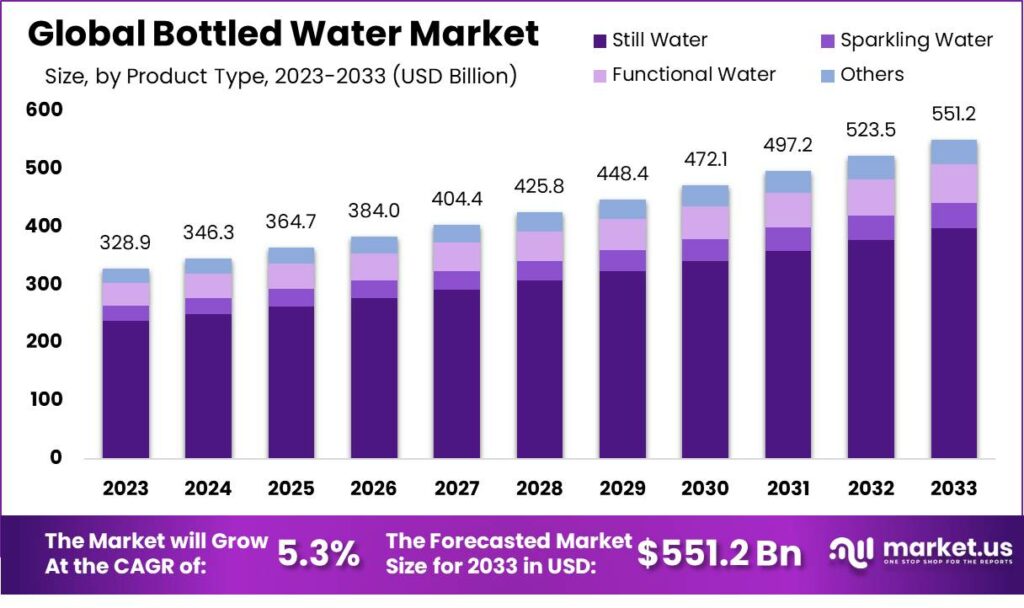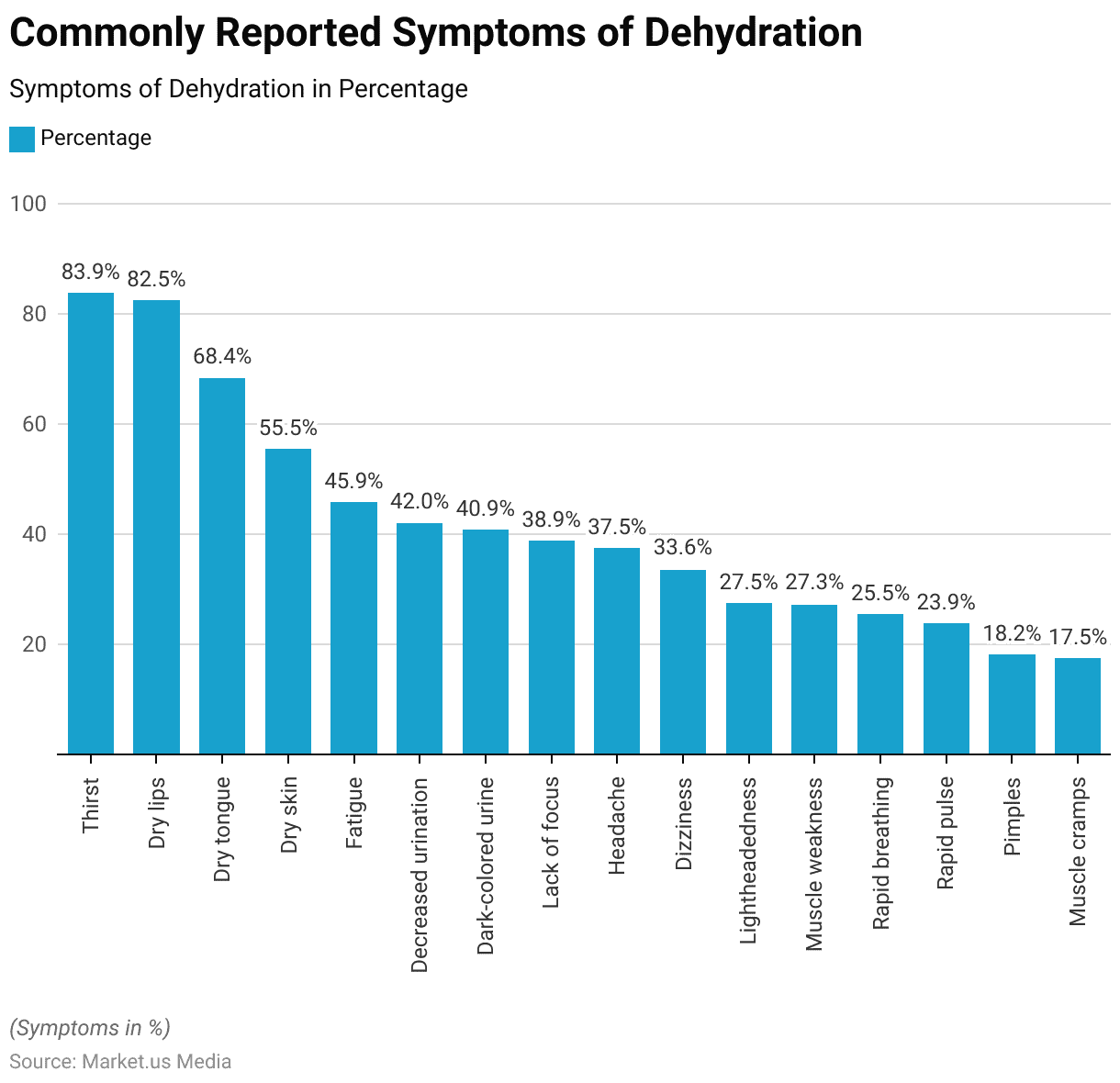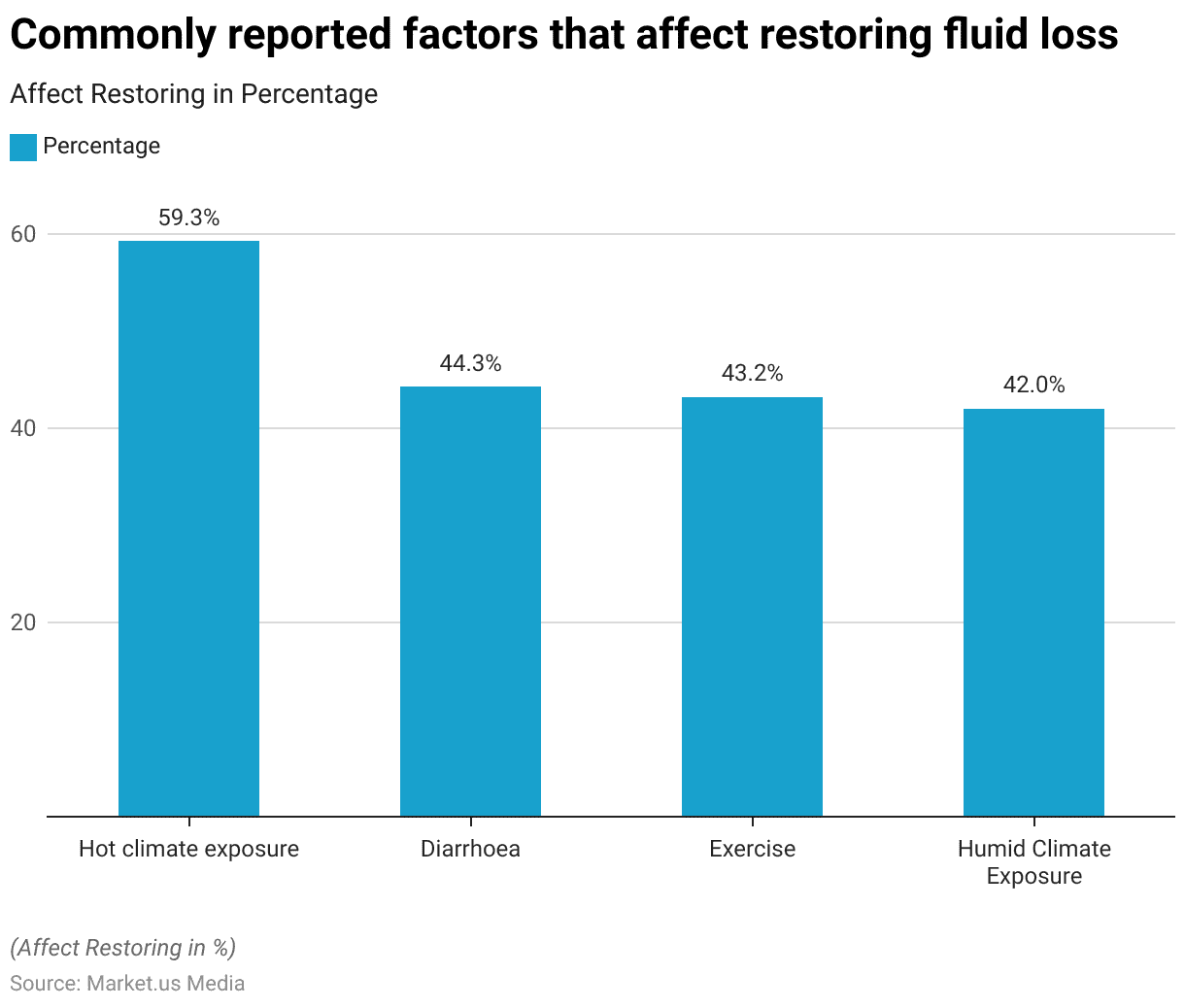Table of Contents
- Introduction
- Editor’s Choice
- Fluid Intake Recommendations
- Causes of Dehydration
- Symptoms of Dehydration
- Factors That Affect Restoring Fluid Loss
- Pediatric Dehydration Statistics
- Adult Dehydration Statistics
- Dehydration Treatment Solutions
- Guidelines for Administration of Dehydration Treatment Solutions
- Initiatives and Programs to Combat Dehydration
- Regulations for Dehydration Products
Introduction
According to Dehydration Statistics, Dehydration occurs when the body loses more fluids than it takes in, disrupting electrolyte balance.
Causes include insufficient fluid intake, excessive sweating (from exercise or heat), illnesses like diarrhea, and certain medical conditions.
Symptoms range from thirst and dry mouth to fatigue, headaches, and dark urine. Severe dehydration can lead to organ damage and other serious complications.
Treatment involves rehydration with water or electrolyte solutions. Prevention focuses on adequate fluid intake, especially in hot weather or during physical activity.
Awareness of dehydration signs and timely intervention are crucial for maintaining health and preventing complications. Particularly in vulnerable populations like children, older adults, and athletes.
Editor’s Choice
- The Bottled Water Market is anticipated to be USD 551.2 billion by 2033. It is estimated to record a steady CAGR of 5.3% in the Forecast period 2023 to 2033. It is likely to total USD 328.9 billion in 2023.
- Dehydration is commonly caused by various factors. With diarrhea being the leading cause, reported by 73.4% of cases.
- Dehydration is associated with a range of symptoms. With thirst being the most commonly reported, affecting 83.9% of individuals.
- Restoring fluid loss is influenced by several commonly reported factors. Exposure to a hot climate significantly impacts fluid restoration, affecting 59.3% of cases.
- Dehydration is a major cause of pediatric illness and death worldwide. Accounting for 14% to 30% of fatalities in infants and toddlers, mainly due to diarrheal diseases.
- In healthy adults weighing around 70 kg, water constitutes approximately 60% of body weight. With a recommended daily intake of 2.0 to 3.5 liters.
- Dehydration prevalence varies by age, affecting 16-21% of individuals. With symptoms like thirst, dry mouth, decreased urination, and darkened urine indicating its presence. Severe dehydration can lead to rapid weight loss.
- In the United States, the Food and Drug Administration (FDA) sets guidelines under the Food Safety Modernization Act (FSMA). Which mandates preventive controls and hazard analysis for dehydrated foods.

Fluid Intake Recommendations
- The recommended daily fluid intake varies by age and gender, with specific guidelines to ensure adequate hydration.
- For infants aged 0–6 months, the intake is 0.7 liters, while infants aged 7–12 months should have a total of 0.8 liters, with 0.6 liters coming from fluids.
- Children aged 1–3 years require 1.0 liters or about 4 cups, and those aged 4–8 years need 1.2 liters or about 5 cups.
- Boys aged 9–13 years are advised to consume 1.6 liters or about 6 cups. Increasing to 1.9 liters or about 7–8 cups for boys aged 14–18 years.
- Girls aged 9–13 years should drink 1.4 liters or about 5–6 cups. While those aged 14–18 years need 1.6 liters or about 6 cups.
- For adults, men aged 19 years and older should aim for 2.6 liters or about 10 cups, and women of the same age should consume 2.1 liters or about 8 cups.
Causes of Dehydration
- Dehydration is commonly caused by various factors. With diarrhea being the leading cause, reported by 73.4% of cases.
- Sweating accounts for 52.05% of dehydration incidents, closely followed by vomiting, which is responsible for 51.82%.
- Fever contributes to 39.8% of dehydration cases, while urination is a cause in 35.9%.
- Additionally, travel is reported as a cause of dehydration in 15.9% of cases.

Symptoms of Dehydration
- Dehydration is associated with a range of symptoms, with thirst being the most commonly reported, affecting 83.9% of individuals.
- Dry lips are experienced by 82.5%, while a dry tongue is reported by 68.4%.
- Dry skin affects 55.5% of those dehydrated, and fatigue is a symptom in 45.9% of cases.
- Decreased urination is noted by 42%, and dark-colored urine is observed by 40.9%.
- Lack of focus impacts 38.9% of individuals, and headache is a symptom for 37.5%.
- Dizziness is reported by 33.6%, and light-headedness by 27.5%.
- Muscle weakness is experienced by 27.3%, while rapid breathing and rapid pulse are reported by 25.5% and 23.9%, respectively.
- Less commonly, dehydration can lead to pimples (18.2%) and muscle cramps (17.5%).

Factors That Affect Restoring Fluid Loss
- Restoring fluid loss is influenced by several commonly reported factors.
- Exposure to a hot climate significantly impacts fluid restoration, affecting 59.3% of cases.
- Diarrhea is another major factor, reported by 44.3% of individuals.
- Exercise contributes to fluid loss in 43.2% of cases, while exposure to a humid climate affects 42% of individuals.

Pediatric Dehydration Statistics
Epidemiology
- Dehydration is a major cause of pediatric illness and death worldwide. Accounting for 14% to 30% of fatalities in infants and toddlers, mainly due to diarrheal diseases.
- According to the World Health Organization (WHO), dehydration results from excessive body water loss. Infants and children have a higher total body water percentage (65% to 80%) than adults. Especially susceptible to dehydration because they cannot effectively communicate their thirst or access fluids on their own.
- Diarrhea and dehydration cause significant health issues and approximately 700,000 to 800,000 child deaths annually, accounting for nearly 16% of global child fatalities.
- Most cases occur in South Asia and Sub-Saharan Africa. The WHO’s efforts reduced mortality by 75% from the 1980s to 2008, but progress has stalled. In Ethiopia, poor sanitation and unsafe water contribute to around 10,000 child deaths yearly.
Etiology, Pathophysiology, and Physiology
- Acute infectious gastroenteritis is the leading cause of dehydration, with viral infections such as rotavirus, norovirus, and enteroviruses responsible for 75% to 90% of global cases.
- Bacterial pathogens account for less than 20%, though in resource-limited countries, this can exceed 25% in children with gastroenteritis.
- In children under 2, rotavirus is the most common cause. Still, since the introduction of the rotavirus vaccine in 2006, hospitalizations for dehydration have declined. While norovirus and other enteric viruses have become more prevalent.
Adult Dehydration Statistics
Epidemiology and Etiology
- In healthy adults weighing around 70 kg, water constitutes approximately 60% of body weight. With a recommended daily intake of 2.0 to 3.5 liters. Water intake comes from three main sources: drinking fluids, water-rich foods, and metabolic processes (endogenous water).
- Even a 3% loss in body weight from water depletion can indicate dehydration. Which is linked to cognitive impairments like poor memory and attention.
- Dehydration prevalence varies by age, affecting 16-21% of individuals, with symptoms like thirst, dry mouth, decreased urination, and darkened urine indicating its presence. Severe dehydration can lead to rapid weight loss.
- Older adults face a higher risk of dehydration, up to 20-30% more than younger adults, due to factors including reduced mobility, impaired thirst sensation, diabetes, renal disease, and susceptibility to falls.
Dehydration Treatment Solutions
Oral Rehydration Solutions and Commonly Used Beverages
Major Beverages
- A comparison of the composition of oral rehydration solutions and commonly used beverages reveals significant differences in their carbohydrate, sodium, potassium, base, and osmolarity content.
- Pedialyte contains 25 g/L of dextrose, 45 mEq/L of sodium, 20 mEq/L of potassium, and 30 mEq/L of base and has an osmolarity of 250 mOsm/kg.
- Enfalyte, with corn syrup as its carbohydrate source, provides 30 g/L of carbohydrates, 50 mEq/L of sodium, 25 mEq/L of potassium, 30 mEq/L of base, and an osmolarity of 200 mOsm/kg.
- CeraLyte, made from rice, offers 40 g/L of carbohydrates, 70 mEq/L of sodium, 20 mEq/L of potassium, ten mEq/L of base, and an osmolarity of 235 mOsm/kg.
- The WHO 2002 solution contains 13.5 g/L of carbohydrates, 75 mEq/L of sodium, 20 mEq/L of potassium, and 30 mEq/L of base and has an osmolarity of 245 mOsm/kg.
Guidelines for Administration of Dehydration Treatment Solutions
Guidelines for Administration of Oral Solutions
- The guidelines for administering oral solutions to replace fluid deficit over four hours differ based on the severity of dehydration.
- For mild dehydration, which is characterized by a fluid loss of 3%–5% of body weight, the total volume of oral solution to be administered over four hours varies by weight. For a body weight of 5 kg, the total volume required is 150–250 mL, administered in 5 mL increments every 5–8 minutes.
- For 10 kg, 300–500 mL is needed, with 6–10 mL administered every 5 minutes. At 15 kg, 450–750 mL should be given in 10–15 mL increments every 5 minutes. For 20 kg, 600–1,000 mL is required, with 12–20 mL administered every 5 minutes.
- For 25 kg, 750–1,250 mL should be given in 15–25 mL increments every 5 minutes. At 30 kg, 900–1,500 mL is needed, with 18–30 mL administered every 5 minutes.
- For a body weight of 40 kg, the total volume required is 1,200–2,000 mL, administered in 25–40 mL increments every 5 minutes.
Initiatives and Programs to Combat Dehydration
- To combat dehydration, various initiatives and programs have been implemented by both government and private organizations.
- The Biden-Harris Administration launched the ALL INside initiative, aimed at reducing unsheltered homelessness, which includes providing essential resources such as clean drinking water to vulnerable populations.
- Private organizations, such as Blanchet House, focus on local efforts to combat dehydration among the homeless by organizing water donation drives, advocating for hydration stations, and distributing bottled water directly to those in need.
- Additionally, GiveWell supports water chlorination programs, which ensure safe drinking water in developing regions, thereby reducing dehydration caused by unsafe water consumption.
Regulations for Dehydration Products
- The regulations for dehydration products vary significantly across different countries, aiming to ensure food safety and consumer protection.
- In the United States, the Food and Drug Administration (FDA) sets guidelines under the Food Safety Modernization Act (FSMA), which mandates preventive controls and hazard analysis for dehydrated foods.
- The European Union follows the European Food Safety Authority (EFSA) regulations, which include strict hygiene standards and labeling requirements.
- In Japan, the Ministry of Health, Labour, and Welfare (MHLW) oversees food safety, emphasizing proper processing and storage practices.
- China’s regulations, managed by the National Health Commission (NHC), focus on food additives and contaminants. At the same time, India’s Food Safety and Standards Authority (FSSAI) mandates compliance with its Food Safety and Standards (Food Products Standards and Food Additives) Regulations.
Discuss your needs with our analyst
Please share your requirements with more details so our analyst can check if they can solve your problem(s)



